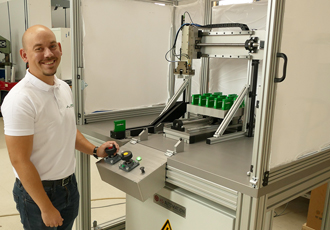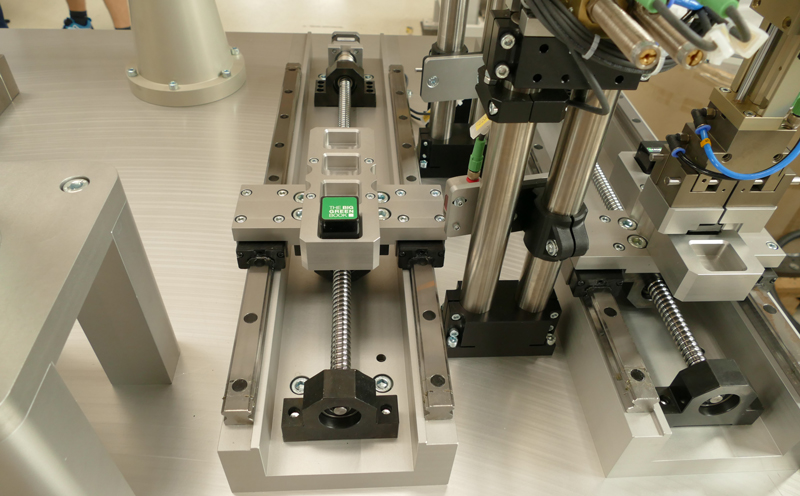The standard way to automation

Approaching automation can be a daunting task for many engineering and manufacturing operators, with costs, complexity, and concerns over workforce morale all big factors to consider. In this interview, Martin Ahner, a leading project engineer from standard components specialists norelem, shows how automation can be easily achieved through standard components, with the help of some recently developed automation examples.
Martin Ahner is a project engineer at norelem, a world-leading manufacturer and supplier of flexible standard parts and components for mechanical engineering.
With a degree in mechanical engineering, Martin has been with norelem for almost four years and can often be seen at global trade fairs and exhibitions to provide technical support to customers. When not flying around, Martin is in the norelem ACADEMY, collaborating with schools and colleges to deliver technical training and develop engineering exhibits.
In your opinion, why is automation required?
One of the key reasons for automation is to ensure a smooth production process, and here the continuous flow of material is crucial. Often, it is the actual production steps that are automated. A machine’s full capacity utilisation can only be achieved if the machine is always supplied with the necessary raw materials or components. Unfortunately, full capacity utilisation is very rarely achieved, as the supply and the waiting times in a company are still far too long, and this is often down to human input. By incorporating simple, automated handling systems, it means engineers and manufacturers could create a higher rate of capacity utilisation for expensive machining centres.
What is the hardest challenge of automation? Is it the complexity of building the machine, the costs or people’s resistance to change?
I think a change in production is influenced by several factors. Of course, there is a sense of fear among employees when steps are suddenly eliminated and replaced by machines. There must be clear communication as to how employees will benefit from such a change going forward. Monotonous work can be omitted, and employees can devote themselves to other tasks. Not every company has employees who are familiar with automation. Sources of good help can be found in consulting firms specialising in automation, or cost-effective and self-explanatory systems.
What is the advantage of building automated machinery from standard components?
For many who may not be using automated machinery currently, it can be a daunting task and may not appear straightforward. There are many bespoke options out there, but choice can be overwhelming, and then you must compare the pros and cons, the maintenance, servicing and operation requirements, along with the initial cost outlay. With standard components, the most diverse requirements can be implemented extremely flexibly. The standardisation of components reduces potential diversity and thus complexity. The automation of a component feed or component handling can reduce set-up times and, with that, costs. Especially for smaller to medium-sized production lines, the use of standard components in the automation sector is an excellent choice.
Typically, how much additional efficiency/productivity can be gained from using automated machines?
You always have to weigh up when automation makes sense for a company. At the beginning, there is always a certain amount of investment, which has to be accepted and then, of course, has to be recouped. Here, each and every company must determine its own break-even point and, if necessary, automate only certain sub-areas.
You have recently built some automated machinery exhibits; can you explain why you did this, and what specific engineering and manufacturing challenges they could solve?
norelem is known as a manufacturer and supplier of standard parts and standardised components. However, our product portfolio has long included parts from the field of drive and handling systems. With these new exhibits, we wanted to show how by combining our range of components together, simple and effective automation can be achieved. Altogether, we have built three working exhibits that show different methods of handling and transporting components from one area of production to the next, which we call the ‘norelem drive’, ‘norelem movement’ and ‘norelem claw’.Due to the modular design of our pneumatic handling modules, such as our small conveyor belts and our linear axes with toothed belt drive, both a simple construction and assembly can be realised.
What do you hope to achieve with these new exhibits? Do you hope to show that automation is easily achievable through standard components?
If you are looking for a simple and fast solution, norelem is the right choice for you. With us, designers can insert all the relevant components into their CAD system and thus assemble their automation both quickly and easily. Thanks to our broad portfolio, we not only offer the handling modules, but also products that allow the complete arrangement to be realised.
Where did you get the idea about what to build these machines from?
The idea originated from our norelem show truck, which we take to customers’ sites to showcase automation and other engineering possibilities. On the truck, we had a ‘pick and place’ automation example, which we found very popular with our customer. Since our enquiries within this area increased, we wanted to present more illustrative examples on a larger scale. The purpose of the new handling and transport exhibits is simply to show our customers just how diverse standard components can be and how they can come together. For example, in the 'norelem movement’ exhibit alone, there are more than 1,200 norelem parts that have been installed! The aim of this exhibit is to simulate a technical run that fulfils a handling task. Pneumatic linear modules, lifting units and rotary modules show the handling tasks of a cylindrical body. A key feature is the linear axis – this shows how easy it is to implement and integrate a component conveyor with this compact unit. Another feature is the customisable small conveyor belt. In the ‘norelem drive’ exhibit we demonstrate an application sample from the field of drive technology. In this machine, more than 400 norelem parts have been installed, including linear, pneumatic and rotary modules, dovetail slides, spur gears and sprockets and more. This exhibit has two areas - one area shows various components from our drive technology group. Spur gears are connected via a universal joint shaft with bevel gears. A 90° offset by the bevel gears in turn allows the different sprockets to be driven. The use of a roller chain, as well as clamping sets, can also be viewed here in more detail. The second area shows our pneumatic handling modules and driven ball screws. The workpiece is our novelty 'norelem cube', implemented in cycles and simulates a component feed.

You worked with engineering students to create these machines. Can you explain how this came about?
We collaborated on the exhibits’ concept development with students of Karlsruhe Institute of Technology in Germany, known as KIT for short. We, as norelem, have always had close ties to young designers and talents. As part of our norelem ACADEMY, we’re always looking to give students their first professional and project experience, and understand engineering outside of the academic environment. In this particular project, we selected a group of students and tasked them with delivering creative automation ideas, which we then assessed and tested. It was a great win-win situation, as the students were paid for their work, as well as getting experience. We then took the ideas to an automation specialist to deliver the final design and implementation phase. Ultimately the whole project was about teamwork – from students for the ideas, to norelem as the component providers, and the automation specialists to assemble it all together.
How should automated machinery be serviced?
For our example applications, a remote maintenance solution is the optimum choice. Faults can be read out at any time and sent to our head office. This permits us to monitor the exhibits independently of their location and remedy possible sources of error remotely. In general, the subject of predictive maintenance and condition monitoring is also becoming increasingly important. By using numerous sensors on the handling units, the system is fed with data, which in turn sounds the alarm before the plant suffers failure or stoppage. This recording of physical parameters ensures ‘round-the-clock’ condition monitoring throughout the process. Early maintenance intervals on high-wear gripper modules help to minimise downtime. Machinery downtime can therefore be prevented thanks to efficient condition monitoring. In future, we want to offer the operator even greater support by equipping some of our products with sensors. This eliminates the need for lengthy and tedious testing, and the data transfer is integrated in the ongoing process. For example, we are working on developing clamping jaws with intelligent clamping force monitoring. Here, a power clamp indicates the clamping force exerted on the workpiece. Long and tedious checking procedures are thus eliminated and data is constantly sent back to monitor the clamp.
Are there any health and safety benefits to automation?
Yes, definitely. Especially when involving monotonous work, the risk of injury for employees is very high. Concentration can quickly wane, and an incorrectly executed work step can lead to injury. Thanks to the automation of handling tasks, we can relieve the employee of these activities and thus also reduce the risk of injury. This should be something that every employer strives for.
What do you hope for the future of automation?
We hope smaller companies can drive forward with the expansion of automation at an ever-greater speed. Cost-effective and standardised handling solutions enable a good start in this area, even when it comes to small companies. Every company must be able to automate sub-areas in the component feed in a simple and efficient manner. For young engineers wishing to learn about automation, then the norelem ACADEMY is a great place to start. Designing with standard parts is an important feature in our lectures, and offering ideas, helping with the design, and providing technical support is what norelem stands for. With our norelem ACADEMY, we aim to pass on our expertise as a manufacturer and industry insider to a new generation of engineers.
Similar articles
More from norelem
- Can CAD data be the future for Industry 4.0? 5th February 2021
- The standard way to automation 25th September 2019
- Design engineers spurred on with plastic gear range 15th April 2019
- Engineering with pinpoint accuracy 24th January 2019












Write a comment
No comments